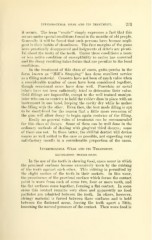Page 465 - My FlipBook
P. 465
INTERPROXIMAL WEAR AND ITS TREATMENT. 211
it occurs. The term "senile" simply expresses a fact that this
occurs under special conditions found in the mouths of old people.
Generally it will be found that such persons have become negli-
gent in their lial)its of cleanliness. The free margins of the gums
have practically disappeared and lodgments of debris are plenti-
ful about the necks of the teeth. Under these conditions a more
or less active condition of susceptibility to caries has occurred
and the decay resulting takes forms that are peculiar to the local
conditions.
In the treatment of this class of cases, gutta-percha in the
form known as "Hill's Stopping" has done excellent service
as a filling material. Cements have not been of much value when
a considerable number of cases have been considered together,
though occasional cases have done well. Porcelain or metal
inlays have not been sufficiently tried to determine their value.
Gold fillings are impossible, except to the well trained manipu-
lator who can so contrive to hold the rubber dam in place with an
instrument in one hand, keeping the cavity dry while he makes
the filling with the other. Even then, the best made filling is apt
to be short-lived for the reason that a little more recession of
the gum will allow decay to begin again rootwise of the filling.
Really no general rules of treatment can be recommended
for this class of decays. Some of them can be well done in the
ordinary methods of dealing with gingival third decays; some
of them can not. In these latter, the skillful dentist will devise
means as well suited to the case as possible, not expecting very
satisfactory results in a considerable proportion of the cases.
Interproximal Wear and its Treatment.
ILLUSTRATIONS: FIGURES 293-297.
In the use of the teeth in chewing food, cases occur in which
the proximal surfaces become excessively worn by the rubbing
of the teeth against each other. This rubbing is permitted by
the slight motion of the teeth in their sockets. In this wear,
the prominence of the proximal surface which forms the contact
point is worn from each of some two, four or more teeth, and
the flat surfaces come together, forming a flat contact. In some
cases this contact remains very close and apparently no food
particles are admitted between the teeth. In others, however,
stringy material is forced between these surfaces and is held
between the flattened areas, forcing the teeth apart a little,
loosening the normal pressure of the contact. Then more food is


